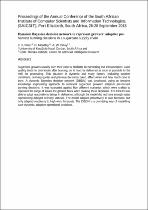 ResearchSpace
ResearchSpace
Dynamic Bayesian decision network to represent growers’ adaptive pre-harvest burning decisions in a sugarcane supply chain
JavaScript is disabled for your browser. Some features of this site may not work without it.
- ResearchSpace
- →
- Research Publications/Outputs
- →
- Conference Publications
- →
- View Item
| dc.contributor.author |
Price, Catherine S

|
|
| dc.contributor.author |
Moodley, Deshendran

|
|
| dc.contributor.author |
Pillay, Anban W

|
|
| dc.date.accessioned | 2019-04-10T10:51:59Z | |
| dc.date.available | 2019-04-10T10:51:59Z | |
| dc.date.issued | 2018-09 | |
| dc.identifier.citation | Price, C.S., Moodley, D. and Pillay, A.W. 2018. Dynamic Bayesian decision network to represent growers’ adaptive pre-harvest burning decisions in a sugarcane supply chain. In: Proceedings of the Annual Conference of the South African Institute of Computer Scientists and Information Technologists, (SAICSIT), Port Elizabeth, South Africa, 26-28 September 2018 | en_US |
| dc.identifier.isbn | 978-1-4503-6647-2 | |
| dc.identifier.uri | https://dl.acm.org/citation.cfm?id=3278681&picked=prox | |
| dc.identifier.uri | http://hdl.handle.net/10204/10933 | |
| dc.description | Presented at: Proceedings of the Annual Conference of the South African Institute of Computer Scientists and Information Technologists, (SAICSIT), Port Elizabeth, South Africa, 26-28 September 2018. Due to copyright restrictions, the attached PDF file only contains the abstract version of the full text item. For access to the full text item, please consult the publisher's website. | en_US |
| dc.description.abstract | Sugarcane growers usually burn their cane to facilitate its harvesting and transportation. Cane quality tends to deteriorate after burning, so it must be delivered as soon as possible to the mill for processing. This situation is dynamic and many factors, including weather conditions, delivery quotas and previous decisions taken, affect when and how much cane to burn. A dynamic Bayesian decision network (DBDN) was developed, using an iterative knowledge engineering approach, to represent sugarcane growers' adaptive pre-harvest burning decisions. It was evaluated against five different scenarios which were crafted to represent the range of issues the grower faces when making these decisions. The DBDN was able to adapt reactively to delays in deliveries, although the model did not have enough states representing delayed delivery statuses. The model adapted proactively to rain forecasts, but only adapted reactively to high wind forecasts. The DBDN is a promising way of modelling such dynamic, adaptive operational decisions. | en_US |
| dc.language.iso | en | en_US |
| dc.publisher | Association for Computing Machinery, Inc. | en_US |
| dc.relation.ispartofseries | Workflow;22135 | |
| dc.subject | Adaptive operational decisions | en_US |
| dc.subject | Burning and harvesting sugarcane | en_US |
| dc.subject | Cognitive model | en_US |
| dc.subject | Dynamic Bayesian decision network | en_US |
| dc.subject | Sugarcane grower | en_US |
| dc.title | Dynamic Bayesian decision network to represent growers’ adaptive pre-harvest burning decisions in a sugarcane supply chain | en_US |
| dc.type | Conference Presentation | en_US |
| dc.identifier.apacitation | Price, C. S., Moodley, D., & Pillay, A. W. (2018). Dynamic Bayesian decision network to represent growers’ adaptive pre-harvest burning decisions in a sugarcane supply chain. Association for Computing Machinery, Inc.. http://hdl.handle.net/10204/10933 | en_ZA |
| dc.identifier.chicagocitation | Price, Catherine S, Deshendran Moodley, and Anban W Pillay. "Dynamic Bayesian decision network to represent growers’ adaptive pre-harvest burning decisions in a sugarcane supply chain." (2018): http://hdl.handle.net/10204/10933 | en_ZA |
| dc.identifier.vancouvercitation | Price CS, Moodley D, Pillay AW, Dynamic Bayesian decision network to represent growers’ adaptive pre-harvest burning decisions in a sugarcane supply chain; Association for Computing Machinery, Inc.; 2018. http://hdl.handle.net/10204/10933 . | en_ZA |
| dc.identifier.ris | TY - Conference Presentation AU - Price, Catherine S AU - Moodley, Deshendran AU - Pillay, Anban W AB - Sugarcane growers usually burn their cane to facilitate its harvesting and transportation. Cane quality tends to deteriorate after burning, so it must be delivered as soon as possible to the mill for processing. This situation is dynamic and many factors, including weather conditions, delivery quotas and previous decisions taken, affect when and how much cane to burn. A dynamic Bayesian decision network (DBDN) was developed, using an iterative knowledge engineering approach, to represent sugarcane growers' adaptive pre-harvest burning decisions. It was evaluated against five different scenarios which were crafted to represent the range of issues the grower faces when making these decisions. The DBDN was able to adapt reactively to delays in deliveries, although the model did not have enough states representing delayed delivery statuses. The model adapted proactively to rain forecasts, but only adapted reactively to high wind forecasts. The DBDN is a promising way of modelling such dynamic, adaptive operational decisions. DA - 2018-09 DB - ResearchSpace DP - CSIR KW - Adaptive operational decisions KW - Burning and harvesting sugarcane KW - Cognitive model KW - Dynamic Bayesian decision network KW - Sugarcane grower LK - https://researchspace.csir.co.za PY - 2018 SM - 978-1-4503-6647-2 T1 - Dynamic Bayesian decision network to represent growers’ adaptive pre-harvest burning decisions in a sugarcane supply chain TI - Dynamic Bayesian decision network to represent growers’ adaptive pre-harvest burning decisions in a sugarcane supply chain UR - http://hdl.handle.net/10204/10933 ER - | en_ZA |





